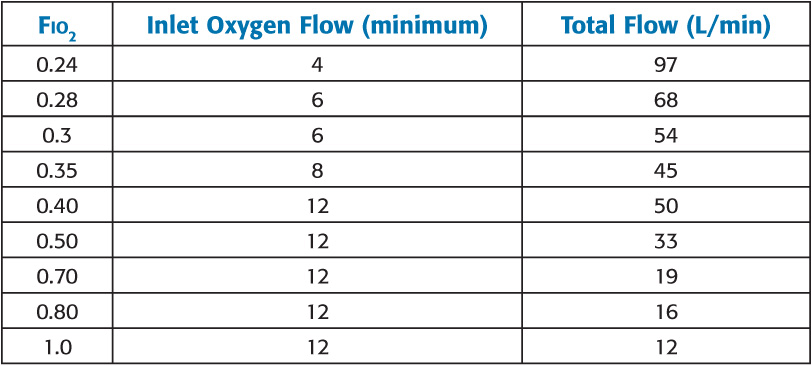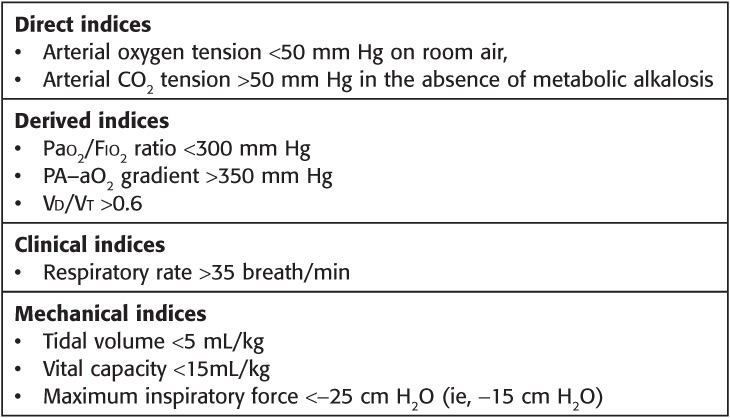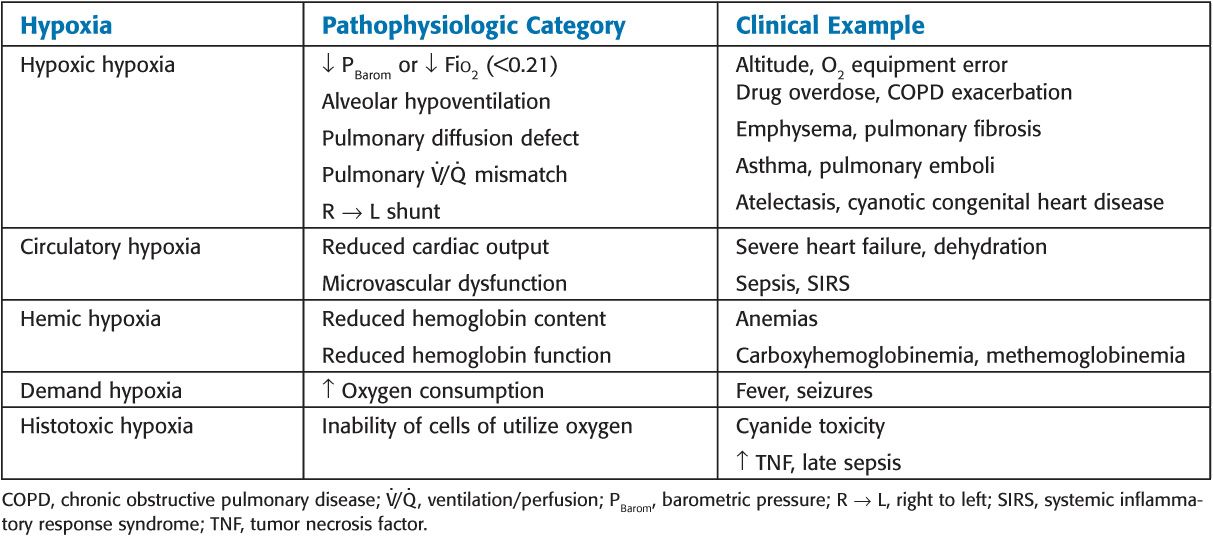Fixed Performance Equipment (High Flow)
Air-entrainment Venturi masks: The gas delivery approach with air-entrainment masks is different than with oxygen reservoirs in that it is an open system with high flow about the nose and mouth, with a fixed FIO2. Oxygen is directed by small-bore tubing to a mixing jet. The entrainment ports can be adjusted to allow varied amounts of room air to mix with oxygen flow and provide a wide range of FIO2.
Oxygen hoods: Hypoxic pediatric patients pose challenges in providing adequate oxygen delivery. These patients usually do not allow caregivers to secure NC or FM oxygen delivery systems easily to their bodies, and sustaining this support is difficult. Oxygen hoods cover the entire head while allowing ongoing access to the patient’s body. The most success for use of the hood is demonstrated in neonates and infants. Hood inlet flows are 10 to 15 L/min. FIO2 monitors are required to determine actual FIO2 delivered.
Helium–oxygen therapy: Helium–oxygen mixtures are called Heliox. The most popular mixture is 79% helium and 21% oxygen, which has a density that is 40% of pure oxygen. Patients with upper airway obstruction (subglottic edema, subglottic stenosis, foreign bodies, or tracheal tumors) and those with lower airway obstruction (asthma) can experience improved oxygen delivery to the alveoli. In lower airway obstruction, Heliox does appear to improve delivery of needed therapies such as bronchodilatory agents (albuterol nebulization).
Anesthesia bag (bag-mask-valve system): Anesthesia bags are 1- to 3-L non–self-inflating reservoirs with a tailpiece gas inlet. The anesthesia bag only inflates with continuous gas flow. Oxygen flow to the anesthesia bag and the pop-off valve (maintains a certain set pressure within the circuit) should be adjusted to create an adequate pressure within the bag to avoid significant deflation during assisted ventilation. Masks used with anesthesia bags must create a seal to allow for needed pressure and inflation of the bag in addition to adequate ventilation and maintenance of positive end-expiratory pressure (PEEP) for the patient. FIO2 can be expected to be 100%. This system is used for patients who are assisted or require full ventilatory support.
Air-Entrainment Mask Input Flow versus Total Flow at Varying FIO2

Mechanical Ventilation
Indicators of the Need for Mechanical Ventilation


General approach: Ventilation provides a tidal volume (TV) delivered at a set rate. The TV can be delivered in either a volume or pressure cycle.
Volume modes terminate inspiration when a preset volume is delivered at a variable pressure. The inspira-tory pressure is determined by the airway or pulmonary disease. The peak inspiratory pressure (PIP) is the pressure created with delivery of the set volume. A PIP limit can be set at which the machine cycles into expiration even if the desired volume has not been delivered to protect against barotrauma. Volume will remain constant even with acute changes in compliance as long as PIP limits have not been reached. Barotrauma is a risk of this mode of ventilation if clinicians are not vigilant.
Pressure modes terminate inspiration when a preset pressure is reached at a variable volume delivery. In other words, oxygen flows into the lungs until the volume creates the preset pressure. That oxygen flow or volume may vary greatly. Although barotrauma is usually not a common risk of this mode of ventilation, significant hypoventilation can occur with a circuit leak, an increase in airway resistance (mucus plug), a decrease in pulmonary compliance (disease), or a circuit obstruction. Volume alarms are not always set, so hypoventilation can be overlooked more easily.
Patient synchrony: A spontaneously breathing patient requires a mode of ventilation that detects inspiratory effort during which to support the patient’s effort. This provides not only patient comfort but also more efficiency of ventilation and oxygenation. Ventilators can monitor patient effort by either pressure or flow sensors; once a predetermined level of effort is reached, the ventilator may provide a full set TV or a pressure supported breath determined by the mode.
Types of Mechanical Ventilation
Controlled mechanical ventilation (CMV): A set TV is delivered at a set rate regardless of patient effort and used successfully in patients who have severe lung disease requiring full support and receiving sedation and usually neuromuscular blockade.
Assist-control ventilation (AC): A set TV is delivered at a set rate, and a TV breath can be delivered when patient effort is detected.
Intermittent mandatory ventilation (IMV): A set TV is delivered at a set rate, and a spontaneous breath can be simply augmented versus fully supported. Pressure support (PS) provides a small volume to assist the patient in overcoming resistance of the ventilator circuit.
Synchronized IMV (SIMV) is the most comfortable mode for patients, providing full support to creating a weaning mode of ventilation. SIMV attempts to time every mechanical breath to coincide with the beginning of spontaneous effort.
• Settings: Tidal volume (cc/kg) or pressure (delta P), rate (breaths/min), PEEP, pressure support (PS), FIO2
Pressure support ventilation (PSV): Mode that augments the tidal volume of spontaneously breathing patient. This helps overcome the inspiratory resistance of the ventilator circuit (endotracheal tube, breathing circuit, humidifier, ventilator). In pure PSV mode, the patient determines the rate of ventilation, and the TV may be variable based on amount of pressure support that is set. Synchronized modes of ventilation (SIMV) can use PS to further augment the patient-initiated breaths.
Inverse I:E ratio ventilation (IRV): This mode of ventilation reverses the normal I:E time ratio of 1:3 to a ratio of greater than 1:1. This is achieved by (1) adding an end-inspiratory pause, (2) decreasing peak inspiratory flow during volume ventilation, or (3) setting inspiratory time longer than expiration during pressure ventilation. This increases intrinsic PEEP, which increases functional residual capacity (FRC), which may improve oxygenation.
Mechanical Ventilation
Initial Ventilator Settings for Full Ventilatory Support
• Mode: CMV, AC, IMV, SIMV
• Rate: 10 to 12 breaths/min
• TV: 6 to 10 mL/kg, which translates to appropriate chest wall excursion
• PS: 5 to 15 cm H2O to support patient-initiated breaths
• PEEP: 5 to 8 cm H2O to maintain alveolar recruitment and decrease pressure required or created with cyclic inflation of alveoli (patient effort)
• FIO2: 0.5 with a goal to wean if tolerated
Monitoring
• Patients may require sedation or neuromuscular blockade to allow for patient–ventilator synchrony.
• Continuous hemodynamic and pulmonary measures should be monitored such as electrocardiography, pulse oximetry, airway pressures (baseline, peak, plateau, and mean), inhaled and exhaled TV, and FIO2.
• Daily chest radiography should be considered to review endotracheal tube positioning in addition to the presence of common complications such as mucus plugging, atelectasis, ventilator-associated pneumonia, and less common complications of barotrauma (e.g., pneumothorax, pneumomediastinum, subcutaneous emphysema).

Full access? Get Clinical Tree





